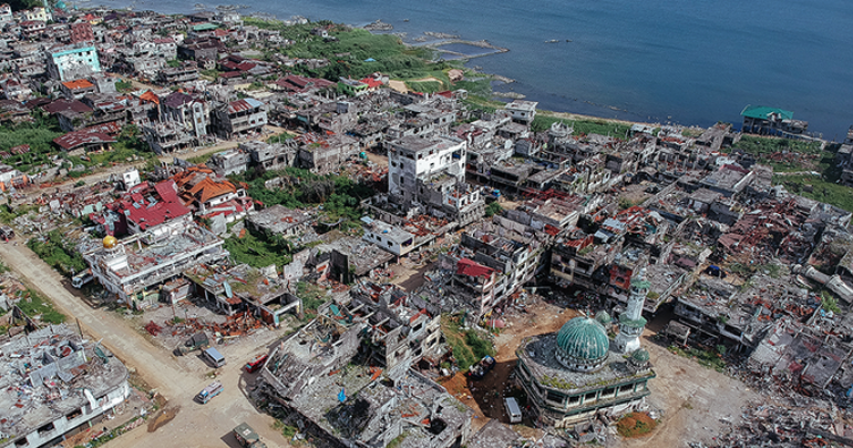Three years after Marawi siege, Philippines to start rebuilding 31 mosques
- 4 years ago

Three years after pro-Daesh terrorists laid siege to the Philippine city of Marawi, the government is ready to rebuild 31 mosques in the area.
The mosques were destroyed during intense combat operations by the military to dislodge members of the Maute group who staged the siege, officials told Arab News on Saturday.
“It’s a welcome development ... the establishment of the destroyed mosques inside the most affected area (MAA) or ground zero, because these are very important to us,” Majul Gandamra, mayor of Marawi City, which is part of the Lanao Del Sur province in the southern Philippines, told Arab News.
He added that reconstruction of the mosques, at a cost of 105 million Philippine pesos ($2.1 million), was “really necessary” and should not be “left behind” as the government rebuilds the war-torn southern city.
It follows a recent visit to the city by Human Settlements and Urban Development Secretary Eduardo del Rosario to inspect rehabilitation work inside the MAA. Del Rosario said that the order to rebuild the mosques was based on a directive by President Rodrigo Duterte.
“That is the order of . . . President Rodrigo Duterte and that will be done,” said Del Rosario, who met the Marawi City clans serving as administrators of the two biggest mosques in the city — the Dansalan Bato Ali Mosque and the Grand Mosque or the Islamic Center.
Del Rosario, who is also the head of the task force in charge of the rehabilitation of Marawi, said that the assigned team had an inventory of the sites that needed total reconstruction and those that required retrofitting and repairs.
Six out of the 31 mosques, including the iconic Bato Mosque and the Grand Mosque, were a top priority, he said.
Based on assessments by government engineers, Bato Mosque where the Maute group held their hostages during the five-month siege is considered “structurally unsound.” The original structure needs to be demolished and a new mosque built. The Grand Mosque, however, can be restored by massive retrofitting and repairs.
Four other mosques are on the priority list.
“During our March meeting with the president, he mentioned that we give priority to the construction of the affected mosques. I am happy to announce that we got a private donation for this,” Del Rosario said.
Mayor Gandamra said that he was confident the government could deliver on its commitment, despite the difficulties in financing the project due to a “prohibition on the disbursement of public funds for the establishment of religious structures” under Philippine law.
“So we are engaging the private sector as in the case of the Bato Mosque and the Grand Mosque, which some private companies have already agreed to help support the construction of these big mosques inside ground zero. So we are very happy with this development,” he said.
Gandamra stressed that the rebuilding of the mosques was “a big thing for the people of Marawi” as the destruction of the religious sites had “greatly impacted them in the same way that the war also destroyed their homes.”
“The mosques are very important to us because these are our places of worship and of course it’s in these significant structures where Muslim people are taught the way of life. So it’s really important for us that these structures are already there before we return to our homes once we’re allowed to go back,” he said. It was unfortunate that radical elements had used these places during the siege to depict a wrong narrative about Islam, he said.
The Marawi siege, launched by the pro-Daesh Maute group, began on May 23, 2017 and lasted until October that year. More than 1,000 militants, government troops and civilians were killed, while the once-bustling city was flattened, displacing more than 100,000 residents.
“We are hoping with the support of the government and our private partners, our mosques will rise again, and perhaps in a much better state than it was before the siege,” Gandamra said. The reconstruction of the mosques “symbolizes hope for all Maranaos,” he said.
“After all we have to move on, and we are going to work hand-in-hand with the government and other partners to rebuild Marawi.”
Meanwhile, Sultan Nasser Sampaco of the Sultanate League of the Philippines, thanked Duterte, Del Rosario and Gandamra for making the reconstruction of Bato Mosque a priority among the other mosques in the area. He said that the structure was a symbol of the Royal Sultanate of Dansalan with three sultans and two datu (or chief) who are also its custodian and administrator.
Built in the 1950s, the Bato Mosque is among the oldest and most renowned places of worship for Muslims, not only in Mindanao but the rest of the country as well.
Comments